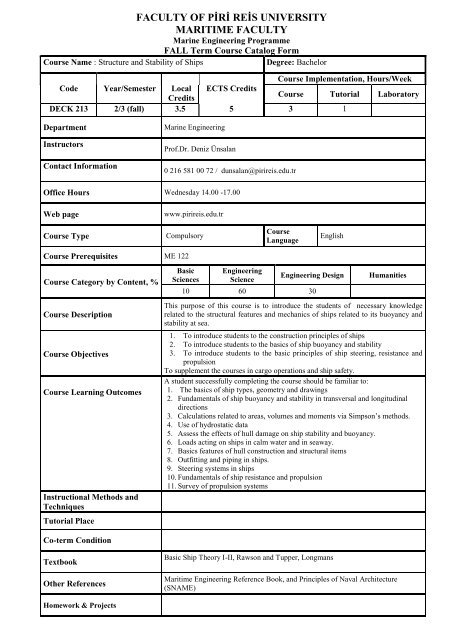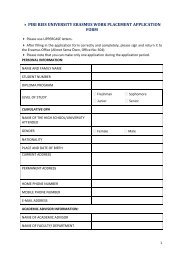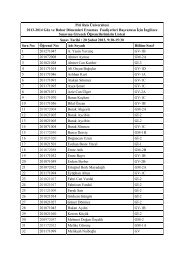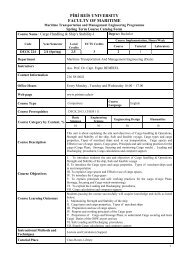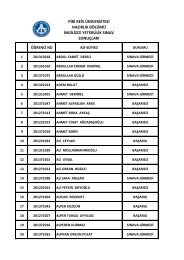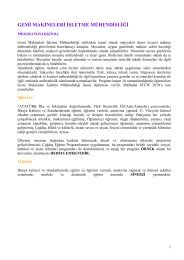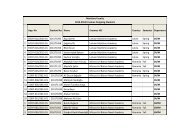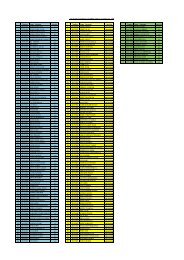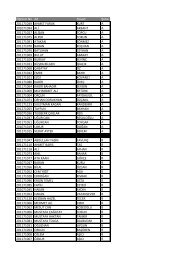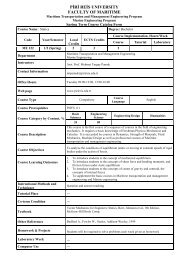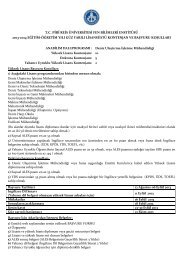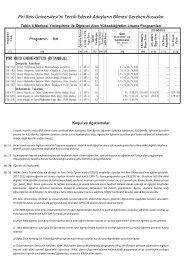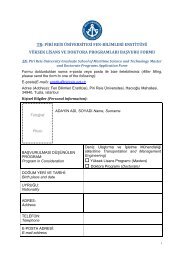Structure and Stability of Ships - Piri Reis Ãniversitesi
Structure and Stability of Ships - Piri Reis Ãniversitesi
Structure and Stability of Ships - Piri Reis Ãniversitesi
You also want an ePaper? Increase the reach of your titles
YUMPU automatically turns print PDFs into web optimized ePapers that Google loves.
FACULTY OF PİRİ REİS UNIVERSITYMARITIME FACULTYMarine Engineering ProgrammeFALL Term Course Catalog FormCourse Name : <strong>Structure</strong> <strong>and</strong> <strong>Stability</strong> <strong>of</strong> <strong>Ships</strong>Degree: BachelorCourse Implementation, Hours/WeekCode Year/Semester Local ECTS CreditsCreditsCourse Tutorial LaboratoryDECK 213 2/3 (fall) 3.5 5 3 1DepartmentInstructorsContact InformationMarine EngineeringPr<strong>of</strong>.Dr. Deniz Ünsalan0 216 581 00 72 / dunsalan@pirireis.edu.trOffice Hours Wednesday 14.00 -17.00Web pagewww.pirireis.edu.trCourse TypeCompulsoryCourseLanguageEnglishCourse Prerequisites ME 122Course Category by Content, %Course DescriptionCourse ObjectivesCourse Learning OutcomesInstructional Methods <strong>and</strong>TechniquesTutorial PlaceBasicSciencesEngineeringScienceEngineering Design10 60 30HumanitiesThis purpose <strong>of</strong> this course is to introduce the students <strong>of</strong> necessary knowledgerelated to the structural features <strong>and</strong> mechanics <strong>of</strong> ships related to its buoyancy <strong>and</strong>stability at sea.1. To introduce students to the construction principles <strong>of</strong> ships2. To introduce students to the basics <strong>of</strong> ship buoyancy <strong>and</strong> stability3. To introduce students to the basic principles <strong>of</strong> ship steering, resistance <strong>and</strong>propulsionTo supplement the courses in cargo operations <strong>and</strong> ship safety.A student successfully completing the course should be familiar to:1. The basics <strong>of</strong> ship types, geometry <strong>and</strong> drawings2. Fundamentals <strong>of</strong> ship buoyancy <strong>and</strong> stability in transversal <strong>and</strong> longitudinaldirections3. Calculations related to areas, volumes <strong>and</strong> moments via Simpson’s methods.4. Use <strong>of</strong> hydrostatic data5. Assess the effects <strong>of</strong> hull damage on ship stability <strong>and</strong> buoyancy.6. Loads acting on ships in calm water <strong>and</strong> in seaway.7. Basics features <strong>of</strong> hull construction <strong>and</strong> structural items8. Outfitting <strong>and</strong> piping in ships.9. Steering systems in ships10. Fundamentals <strong>of</strong> ship resistance <strong>and</strong> propulsion11. Survey <strong>of</strong> propulsion systemsCo-term ConditionTextbookOther ReferencesBasic Ship Theory I-II, Rawson <strong>and</strong> Tupper, LongmansMaritime Engineering Reference Book, <strong>and</strong> Principles <strong>of</strong> Naval Architecture(SNAME)Homework & Projects
Laboratory WorkComputer UseOther ActivitiesA visit to a local shipyardAssessment CriteriaActivities Quantity Effects on Grading, %AttendanceMidterm 1 35Quiz 1 5HomeworkTerm Paper/ProjectLaboratory WorkPracticesTutorialSeminarPresentationField StudyFinal Exam 1 60TOTAL 100Effects <strong>of</strong> Midterm on Grading, % 40Effects <strong>of</strong> Final on Grading, % 60TOTAL 100WeekTopicsCourseOutcomes1 Introduction to ships, classification <strong>of</strong> ships 12 Introduction to ship geometry, dimensions related to ships, coefficients <strong>of</strong> form 1,23 Lines plan <strong>of</strong> ships, table <strong>of</strong> <strong>of</strong>fsets. Calculations <strong>of</strong> areas <strong>and</strong> volumes via Simpson’s method 1,24 Basics <strong>of</strong> ship stability, the concept <strong>of</strong> metacenter <strong>and</strong> stability curve 2,35 Longitudinal stability <strong>of</strong> ships, trim 3,46 <strong>Stability</strong> parameters from the table <strong>of</strong> <strong>of</strong>fsets <strong>of</strong> ship, curves <strong>of</strong> stability 3,47 Damaged stability <strong>and</strong> stability when grounded or drydocked 58 Mid – Term Exam9 Forces <strong>and</strong> moments acting on a ship in calm water <strong>and</strong> at sea 610 Ship structure treated as a beam, distributions <strong>of</strong> weight, buoyancy, shear force <strong>and</strong> bending 6moment11 Structural elements <strong>of</strong> a ship <strong>and</strong> constructional details 712 Outfitting <strong>and</strong> piping systems 813 Steering <strong>of</strong> ships <strong>and</strong> rudders 914 Resistance <strong>of</strong> ships <strong>and</strong> propulsion, propulsors 10,11
Relationship between the Course <strong>and</strong> the Marine Engineering CurriculumLevel <strong>of</strong>Program OutcomesContribution1 2 3a An ability to apply knowledge <strong>of</strong> mathematics, science, <strong>and</strong> engineering Xb An ability to design <strong>and</strong> conduct experiments, as well as to analyze <strong>and</strong> interpret data Xc An ability to design a system, component or process to meet desired needs Xd Ability to function on multi-disciplinary teams Xe An ability to identify, formulate, <strong>and</strong> solve engineering problems Xf An underst<strong>and</strong>ing <strong>of</strong> pr<strong>of</strong>essional <strong>and</strong> ethical responsibility Xg An ability to communicate effectively XhXThe broad education necessary to underst<strong>and</strong> the impact <strong>of</strong> engineering solutions in a global <strong>and</strong> societalcontexti A recognition <strong>of</strong> the need for, <strong>and</strong> an ability to engage in life-long learning Xj A knowledge <strong>of</strong> contemporary issues Xk An ability to use the techniques, skills <strong>and</strong> modern engineering tools necessary for engineering practice XlmAn ability to apply legal, societal <strong>and</strong> environmental knowlegde in maritime transport <strong>and</strong> in all respectivemodes <strong>of</strong> transport operations.An ability to interpret <strong>and</strong> analysis <strong>of</strong> the data regarding maritime management <strong>and</strong> operations, recognition<strong>and</strong> solution <strong>of</strong> problems for decision making process.1: Small, 2: Partial, 3: FullXXPrepared byPr<strong>of</strong>.Dr. Deniz ÜNSALANDate2.03.2012Signature


